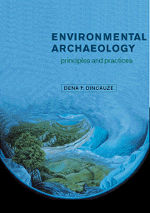Book contents
- Frontmatter
- Contents
- List of figures
- List of tables
- Preface
- Acknowledgments
- Glossary
- PART I INTRODUCTION
- PART II CHRONOLOGY
- PART III CLIMATE
- PART IV GEOMORPHOLOGY
- PART V SEDIMENTS AND SOILS
- 11 BASIC PRINCIPLES OF SEDIMENTOLOGY AND SOILS SCIENCE
- 12 ARCHAEOLOGICAL MATRICES
- Case Study: Did the Classical civilizations destroy their own agricultural lands?
- PART VI VEGETATION
- PART VII FAUNA
- PART VIII INTEGRATION
- References
- Index
11 - BASIC PRINCIPLES OF SEDIMENTOLOGY AND SOILS SCIENCE
Published online by Cambridge University Press: 20 January 2010
- Frontmatter
- Contents
- List of figures
- List of tables
- Preface
- Acknowledgments
- Glossary
- PART I INTRODUCTION
- PART II CHRONOLOGY
- PART III CLIMATE
- PART IV GEOMORPHOLOGY
- PART V SEDIMENTS AND SOILS
- 11 BASIC PRINCIPLES OF SEDIMENTOLOGY AND SOILS SCIENCE
- 12 ARCHAEOLOGICAL MATRICES
- Case Study: Did the Classical civilizations destroy their own agricultural lands?
- PART VI VEGETATION
- PART VII FAUNA
- PART VIII INTEGRATION
- References
- Index
Summary
To the field archaeologist the most obvious – and often the most abundant – constituent of a site is dirt … Dirt, properly called soil or sediment, is the subject matter of sedimentology.
SCHIFFER 1987: 200Sediments are composed variously of particles of disaggregated rock, dust from whatever source, bits of dead animals and plants, and chemical precipitates. Their deposition on the surface of the Earth or the bottom of lakes and seas creates threedimensional sedimentary bodies (deposits) which are subsequently modified in characteristic ways by the five spheres of the climate system. In company with bedrock, sediments underlie the landforms on which life processes occur. For archaeologists, sediments are the enclosing medium and the environment for the physical and chemical remains that comprise archaeological sites.
INTRODUCTORY CONCEPTS
In contrast to the readiness with which archaeologists borrow geomorphological techniques for identification and description of landforms, developments in petrographic techniques seem to be adopted slowly and reluctantly by them. Methods for the technical description and interpretation of sediments and soils, particularly, need further development and more intensive application in archaeology. As with fish that cannot be expected to be aware of water, archaeologists often take for granted the materials within which their sites occur, rather than seeing them as problems and interpretive opportunities. Skilled geoarchaeological work remains, regrettably, a specialist domain instead of being incorporated as a matter of course in all field work.
Minerals are inorganic chemical compounds in crystalline form; rocks are composed primarily of minerals, sometimes accompanied by organic detritus and chemical precipitates. Mineral matter of the regolith recirculates through cycles of exposure, erosion, deposition, and burial at the surface of the Earth.
- Type
- Chapter
- Information
- Environmental ArchaeologyPrinciples and Practice, pp. 257 - 290Publisher: Cambridge University PressPrint publication year: 2000

